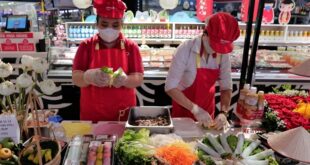U.S. coffee chain Starbucks is struggling to grow in China where local competitors have been expanding fast, beating it in both number of stores and revenues.
Starbucks saw revenue from over 7,300 stores in mainland China dropped 11% year-on-year to $734 million in the second quarter this year.
Same-store sales declined by 14%, compared to the 2% fall in the U.S., as Chinese customers visited less often and spent less per visit, the company said in a financial disclosure.
Chinese coffee chains, meanwhile, have been offering customers drinks at a much lower price to compete with the U.S. giant who has been in China since 1999.
Cotti, which opened 7,500 stores in the last two years alone, attracts customers with a CNY9.9 (US$1.40) price tag for all drinks, while a tall latte costs three times more at Starbucks,
The local chain has been expanding fast with stores as small as one square meter mushrooming in populated areas.
“Starbucks will continue to lose market share in China over the near term, driven in no small part by consumer trade-down and more cost-effective options widely available with local competitors,” Sean Dunlop, a senior equity analyst at Morningstar, said in a note as cited by SCMP.
The American chain is also facing pressure from Luckin, China’s biggest coffee chain with over 20,000 stores.
Although Starbucks said in 2022 it would open one new store every nine hours over the next three years in China to boost revenues, it fell to the second place in sales behind Luckin last year.
Starbucks has been trying to reclaim share in the market by offering discounts of up to 30%.
Data examined by Reuters show that there has been an increase in discount coupons being offered by Starbucks through its own mini-programs, as well as via the coffee-maker’s livestreams on Douyin, and third-party delivery platforms.
The chain does not really have a choice but to compete to some degree on price in a market where low cost battles have become “the new normal,” said Jason Yu, greater China managing director of market research firm Kantar Worldpanel.
“Strengthening the promotional offers and increasing the intensity of their promotions, being very active on social media, are essential moves to maintain their position so market share is not further eroded,” he added.
Despite recording daunting figures, Starbucks remains optimistic in the China market.
Its CEO Laxman Narasimhan said the company still has immense opportunity in China, and is in the early stages of exploring a strategic partnership or joint venture that could help it accelerate its growth.
He added that such a partnership could also lessen Starbucks’ exposure to the market’s volatility.
Analysts, however, do not share the same outlook.
“The growth potential of China’s coffee market definitely lies in lower-tier cities, given that the higher-tier cities are already very saturated,” Richard Lin, chief consumer analyst at SPDB International, told SCMP.
“I do not think Starbucks can gain a lot of traction in China’s small towns and villages.”
Kantar’s Yu said that though price will be an important factor in consumer decision-making for the foreseeable future, Starbucks won’t beat its competition in a race to the bottom.
He added that the American firm should continue with its strategy of offering a premium in-store experience its competitors can’t match.
“Starbucks needs to compete on price but not only compete on price,” he said. “They need to lead in innovation, lead in the conversation about coffee and lead in creating emotional value for consumers, or they will lose out more to the local competition.”
- Reduce Hair Loss with PURA D’OR Gold Label Shampoo
- Castor Oil Has Made a “Huge” Difference With Hair and Brow Growth
- Excessive hair loss in men: Signs of illness that cannot be subjective
- Dịch Vụ SEO Website ở Los Angeles, CA: đưa trang web doanh nghiệp bạn lên top Google
- Nails Salon Sierra Madre
 VnExpress News The News Gateway of Vietnam
VnExpress News The News Gateway of Vietnam




